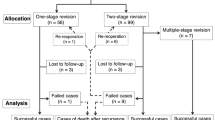Abstract
Infection is a complication that occurs in a considerable percentage of hip prostheses replacements, being in many cases necessary to retire them, which generates important health and economical problems. Objectives: To know the distribution of infection and its risk factors in total hip replacement. Material and methods: A four year prospective study was developed in the rehabilitation and orthopedic center of ‘La Paz’ Hospital. A total of 873 patients were included. Patients were controlled by means of active epidemiological surveillance until the day of discharge, listing up their characteristics at admission and risk factors during their stay. A multivariant study was carried out to determine risk factors. Results: Patients, average age was 63 years, 3.4% of them suffered from diabetes and there were no inmunocompromised patients. The percentage of wound infection during the four years was 6%, being reduced to 1.2% in the last year. The risk factors found in the multivariant study were: incorrect prophylaxis (OR: 3.85), wrong scaring (OR: 14.06), suffering more than one intervention (OR: 7.31) and a hospitalization period longer than 30 days (OR: 2.84). Conclusion: We think that special attention in the care of the surgical wound, as well as the correct use of prophylaxis, can significantly collaborate to the reduction of infection.
Similar content being viewed by others
References
Weber FA, Orth M, Lautenbach EEG. Revision of infected total hip arthroplasty. Clin Orthop Rel Res 1986; 211: 108–115.
Fitzgeral Jr RH. Infections of hip prostheses and artificial joints. Infec Dis Clin N A 1989; 3: 329–338.
Andrews HJ, Arden GP, Hart GM, Owen JW. Deep infection after total hip replacement. J Bone J Surg 1981; 63: 53–57.
Sanderson PJ, Infection in orthopaedic implants. J Hosp Infec 1991; 18: 367–375.
Petty W. Infections of skeletal prostheses. In: Bennett-Brachman (ed), Hospital infections. Boston: Little Brown, 1990: 749–766.
Garner JS, Jarvis WR, Emori TG. CDC definitions for nosocomial infections. Am J Infec Cont 1988; 16: 128–140.
Hosmer DW, Lemmeshow S. Model-building strategies and methods for logistic regression. In: Wiley (ed), Aplied logistic regression. Interscience, 1990: 83–134.
Kleinbaum DG, Kupper LL, Muller KE. Dummy variables in regression. In: PWS Kent (ed), Applied logistic regression and other multivariable methods. Boston, 1988: 260–296.
Hanley JA, McNeil BJ. The meaning and use of area under a reciver operating characteristics (ROC) curve. Radiol 1982; 143: 29–36.
Hanley JA, McNeil BJ. A method of comparing the areas under reciver operating characteristics curves derived from the same cases. Radiology 1983; 148: 839–843.
Author information
Authors and Affiliations
Rights and permissions
About this article
Cite this article
Arjona, M.F., Gómez-Sancha, F., Ibarra, F.P. et al. Risk infection factors in the total hip replacement. Eur J Epidemiol 13, 443–446 (1997). https://doi.org/10.1023/A:1007379502953
Issue Date:
DOI: https://doi.org/10.1023/A:1007379502953




